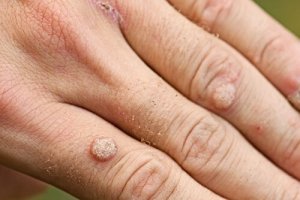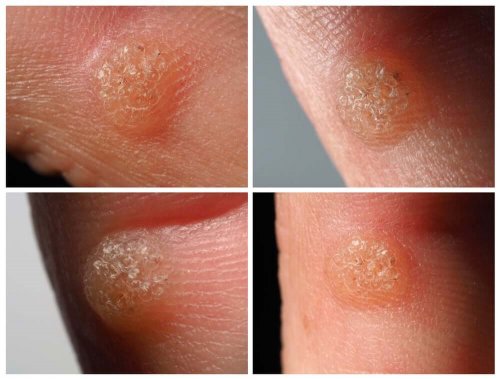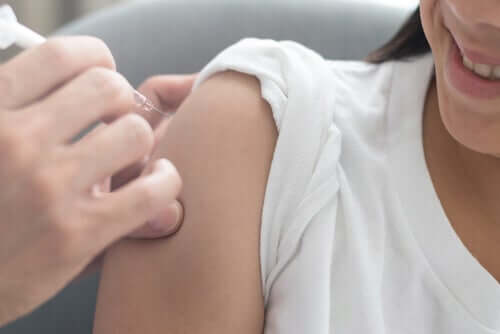Types of Warts and Treatments

Warts are a very common problem. Normally, they’re only aesthetically bothersome. However, depending on where they appear, they can cause discomfort. Warts are small skin growths that usually aren’t painful.
Although many people don’t know it, the main cause of warts is a virus. Specifically, it’s the human papillomavirus (HPV), which has more than 100 different subtypes. This means that are are many different types of warts, and they can appear in different places. However, they mostly manifest in the hands and feet. Sometimes, it’s necessary to treat them so the affected person doesn’t suffer discomfort.
In this article, we’ll explain the most common types of warts and how they’re treated.
What are warts?
Warts are small bumps that appear on the skin. Normally, they’re the same color as the skin, although they can be whitish or pink. Some even have blacks spots, which are coagulated blood vessels, on their surface.
As we mentioned above, the cause of warts is the human papillomavirus. This is a virus with many subtypes, which is why many people come into contact with it. However, warts aren’t that common. In other words, not all people who have come into contact with the virus develop them. This is because anyone in good health can successfully fight the virus, meaning they won’t develop symptoms.
Thus, warts are more common in children or people with weakened immune systems because they can’t fight the infection. Warts can appear up to six months after the initial contact with the virus.
Most types of the virus are spread through skin contact or objects such as towels. However, we can’t forget that certain types are sexually transmitted, such as the human papillomavirus 16 or 18, which are the types that are most associated with cervical cancer. Furthermore, warts spread easily. For example, it’s common to see a child with warts on their fingers biting their nails. Thus, it can cause more warts to appear on their hand or face.

You may like this article: Human Papillomavirus (HPV): How It Affects Sex
What types of warts exist?
There are many different types of warts, depending on their shape and location. Firstly, we must highlight common warts. They’re round, rough, and tend to appear on the hands and feet. Other types are:
- Flat warts. These are most common in young children. They’re small and tend to form small groups or clusters.
- Filiform. They’re more elongated and soft, like a tiny finger. They’re common in the neck or eyelids.
- Plantar. These tend to appear at the bottom of the feet or toes. They’re very bothersome since walking causes continuous pressure on them.
- Genital warts. These appear in both male and female genitals and even in the groin area or anus. These tend to be transmitted through sexual contact. They’re also called condylomas.
Of all these types, genital warts are the most important to look out for, since the human papillomavirus is a potential carcinogen. Also, because infection is very common, you should monitor these lesions. In fact, there are now vaccines for certain types of papillomavirus. They’re applied to young women in many countries because it’s been shown that cervical cancer is highly related to this virus.

This article may interest you: HPV: Everything You Need to Know
Treatment
Most warts are treated only for cosmetic reasons or discomfort, as they can produce friction or pain caused by pressure. With treatment, the goal isn’t only to destroy the wart but also to ensure that the immune system fights the virus.
Nowadays, there are different ways to achieve this. Cryotherapy is a technique that consists of applying cold to the wart to get it to fall off. Laser or minor surgery are also used to remove them. There are even certain acid medications that eliminate warts. However, it’s best to consult with your doctor, as they’ll help you decide the best treatment depending on the type of wart.
All cited sources were thoroughly reviewed by our team to ensure their quality, reliability, currency, and validity. The bibliography of this article was considered reliable and of academic or scientific accuracy.
- Allevato, M. A., and Lucila B. Donatti. “Verrugas genitales.” Act Terap Dermatol 28 (2005): 302-312.
- Domíguez, Hugo Fernández, Abián Mosquera Fernández, and Benigno Monteagudo Sánchez. “Revisión bibliográfica de los tratamientos de la verruga plantar.” Revista española de podología 25.4 (2014): 138-141.
- Llardén-Garcia, M., M. Pena-Arnáiz, and J. M. Casanova-Seuma. “Tratamiento actual de las verrugas.” FMC-Formación Médica Continuada en Atención Primaria 13.1 (2006): 45-54.
This text is provided for informational purposes only and does not replace consultation with a professional. If in doubt, consult your specialist.








